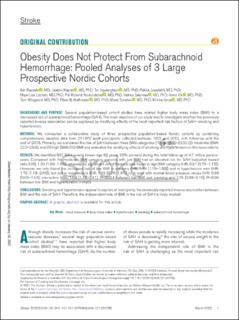| dc.description.abstract | Background and Purpose:
Several population-based cohort studies have related higher body mass index (BMI) to a decreased risk of subarachnoid hemorrhage (SAH). The main objective of our study was to investigate whether the previously reported inverse association can be explained by modifying effects of the most important risk factors of SAH—smoking and hypertension.
Methods:
We conducted a collaborative study of three prospective population-based Nordic cohorts by combining comprehensive baseline data from 211 972 adult participants collected between 1972 and 2012, with follow-up until the end of 2018. Primarily, we compared the risk of SAH between three BMI categories: (1) low (BMI<22.5), (2) moderate (BMI: 22.5–29.9), and (3) high (BMI≥30) BMI and evaluated the modifying effects of smoking and hypertension on the associations.
Results:
We identified 831 SAH events (mean age 62 years, 55% women) during the total follow-up of 4.7 million person-years. Compared with the moderate BMI category, persons with low BMI had an elevated risk for SAH (adjusted hazard ratio [HR], 1.30 [1.09–1.55]), whereas no significant risk difference was found in high BMI category (HR, 0.91 [0.73–1.13]). However, we only found the increased risk of low BMI in smokers (HR, 1.49 [1.19–1.88]) and in hypertensive men (HR, 1.72 [1.18–2.50]), but not in nonsmokers (HR, 1.02 [0.76–1.37]) or in men with normal blood pressure values (HR, 0.98 [0.63–1.54]; interaction HRs, 1.68 [1.18–2.41], P=0.004 between low BMI and smoking and 1.76 [0.98–3.13], P=0.06 between low BMI and hypertension in men).
Conclusions:
Smoking and hypertension appear to explain, at least partly, the previously reported inverse association between BMI and the risk of SAH. Therefore, the independent role of BMI in the risk of SAH is likely modest. | en_US |

